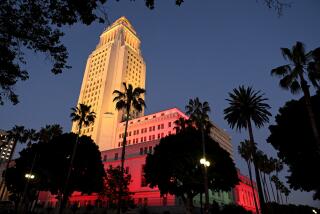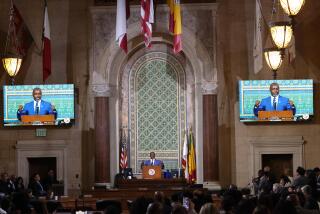Grocer, Doctor, Gambling Man, Clerk ...
- Share via
Mayor Antonio Villaraigosa, who is the 41st mayor of Los Angeles, takes over a job with a colorful history. Here’s a look at how L.A.’s 40 former mayors are remembered, if at all.
Alpheus P. Hodges
1850-51
Hodges was mayor and coroner. He received no pay as mayor but earned $100 for each inquest of a “dead Indian.” His hallmark was his youth when he took office -- 28 years old, still a record.
Benjamin D. Wilson
1851-52
A winemaker and land baron, Wilson was the first elected full-time mayor. He also organized the first police force.
John G. Nichols
1852-53, 1856-59
Nichols, a grocer, lived in the first brick house and his son was the first American born in L.A.
Antonio F. Coronel
1853-54
Coronel, sworn in kneeling before a makeshift altar, established the Department of Public Works. He encouraged residents to gather in the plaza at the sound of a gong and vote on city matters by a show of hands.
Stephen C. Foster
1854-55, 1856
Solidifying his “law and order” pledge, Foster scrambled atop a beer keg and announced his brief resignation to head a lynch mob. When the Yale graduate resumed the job, he started a chain gang to build new streets.
Thomas Foster
1855-56
Foster, a physician, enforced a $3 fine on those who bathed or washed their clothes in the zanja madre, the city’s water system. He sent a wagon dubbed the “Black Maria” to cart off smallpox victims.
Damien Marchessault
1859-60, 1861-65
A carousing onetime New Orleans gambler, Marchessault and a partner laid wooden water pipes that burst and turned streets into sinkholes. Struggling with mounting debts, he slipped into an empty City Council chamber on Jan. 20, 1868, and shot himself to death.
Henry Mellus
1860
An entrepreneur and a bookish Bostonian, Mellus sailed around Cape Horn in 1835 with Richard Henry Dana Jr., author of “Two Years Before the Mast.”
Jose Mascarel
1865-66
A former French sea captain, Mascarel spoke Spanish and French but little English. During the Civil War, when the Union Army’s Maj. Gen. Irvin McDowell scheduled a visit, it was feared that his language skills might prove an embarrassment. Fortunately, McDowell spoke French.
Cristobal Aguilar
1866-68, 1871-72
Aguilar vetoed a proposed sale of the city water system and started the Department of Water and Power. He failed in a bid for a third term when his opponent made an issue of his flawed English. He was the last Latino mayor before Villaraigosa.
Joel H. Turner
1868-70
Turner is perhaps best known for startling Secretary of State William Seward by “ambushing” his stagecoach with a band of troubadours “all tricked out in ribbons and spangles in old-time Californian style.”
James R. Toberman
1872-74, 1878-82
Toberman, who sported a droopy mustache, was a bit of a skinflint. He budgeted $25 for the welcoming ceremonies for Rutherford B. Hayes, the first American president to visit L.A.
Prudent Beaudry
1874-76
Beaudry was pitied as a fool for paying $517 for 20 acres of “howling coyote wilderness.” He piped water to it in 1875 and, because it was the 100th anniversary of the Battle of Bunker Hill, he named it accordingly.
Frederick Alexander MacDougall
1876-78
Scottish-born MacDougall was a charter member of the city’s first all-male social club.
Bernard Cohn
1878
Appointed mayor for two weeks after MacDougall died in office.
Cameron Erskine Thom
1882-84
Elysian Park was established when he was mayor. An attorney, he helped draft the City Charter.
Edward F. Spence
1884-86
A businessman and banker, Spence helped found USC.
William H. Workman
1886-88
A former saddle-and-harness dealer, Workman helped import water from the north, developed Boyle Heights and devised an Eastside streetcar system.
John Bryson
1888-89
Bryson’s wife publicly demanded that the real estate mogul live with his girlfriend outside the city limits. “I would rather die than agree to any such crazy proposition as that,” he said.
Henry T. Hazard
1889-92
Hazard, a businessman and attorney, was in a barber’s chair, lathered with shaving cream, when the 1871 Chinese Massacre broke out. With shaving cream on his face, he drew his revolver and plunged into the murderous mob to rescue hapless victims.
Thomas E. Rowan
1892-94
Owner of the American Baking Co., his real interest was politics and shenanigans. Rowan sponsored the first “La Fiesta de Los Angeles,” which endures as Fiesta Broadway. Newspaper accounts report Rowan and others paraded in “weird and terrible costumes.”
Frank Rader
1894-95
An innocent-looking man with a handlebar mustache and wavy hair, Rader fought for federal money to develop a port.
Meredith Pinxton Snyder
1896-98, 1900-04, 1919-21
The former furniture store clerk was a durable Democrat in a period of Republican ascendancy. But he refused to clamp down on the oil industry.
Fred Eaton
1898-1900
A visionary engineer, Eaton tried to solve the city’s water crisis. After he left office, he hatched an ambitious plan for an aqueduct to divert water to Los Angeles from the Owens Valley.
Owen C. McAleer
1904-06
The first whisker-free mayor in more than 50 years, McAleer helped oust the city librarian in 1905 to make way for a former Los Angeles Times editor.
Arthur C. Harper
1906-09
Harper stepped down in 1909 amid charges that he was taking payoffs from casinos and frequenting downtown brothels.
William D. Stephens
1909
Filled in for less than two weeks after Harper resigned.
George Alexander
1909-13
A former grain dealer, Alexander was a progressive reformer, avid prohibitionist and anti-unionist. After union agitators dynamited the Times building in 1910, he hired the private detective who broke the case.
Henry R. Rose
1913-15
A socialist and progressive, Rose was also a crack pistol shot, winning many matches, even against the police chief.
Charles E. Sebastian
1915-16
He rose from a flatfoot in the Police Department to chief of police and then mayor, a feat never repeated. He quit after a newspaper printed love letters to his girlfriend in which he called his wife “the Old Haybag.”
Frederick T. Woodman
1916-19
Woodman was indicted on charges of accepting bribes from the vice squad. Although he was acquitted, it led to his downfall.
George E. Cryer
1921-29
Cryer, a police officer and a lawyer, was known as the hiking mayor for popularizing Griffith Park’s trails.
John C. Porter
1929-33
A used-car dealer, Porter combined reform politics with Protestant populism. He nearly caused an international incident in France when he refused to drink a champagne toast to the president, noting that Prohibition was in effect in the U.S.
Frank L. Shaw
1933-38
He handed out keys to the city but put his brother on the payroll as “private secretary” and appointed a dishonest police chief. A recall sent him and his chief into retirement. Some historians believe that the overthrow of the Shaw machine drove the L.A. mob to Las Vegas.
Fletcher Bowron
1938-53
A former Superior Court judge, Bowron was a law-and-order mayor who in World War II called for the roundup of enemy aliens and their children “who are more dangerous because of their command of English.”
Norris Poulson
1953-61
During a dinner at the Ambassador Hotel in 1959, mild-mannered Poulson scolded Soviet Premier Nikita Khrushchev for his boast that communism would “bury” capitalism. Poulson retorted: “You shall not bury us and we shall not bury you.”
Sam Yorty
1961-73
Known as “traveling Sam” because he was out of town 372 days in a 3 1/2 -year period, the feisty Yorty gained national attention with his unsolicited advice to President Lyndon B. Johnson on such matters as the Vietnam War and Palestinian refugees.
Tom Bradley
1973-1993
Shrewd and silent, Bradley, the city’s first and only black mayor, presided over its rise to world-city status as corporate towers rose.
Richard Riordan
1993-2001
Riordan led moves to reform the L.A. school board and the City Charter. The bicycle-riding millionaire was known for his temper and his off-kilter sense of humor.
James K. Hahn
2001-2005
After he lost his reelection bid, Hahn said he suffered from “charisma deficit disorder.” His one term was marked by two bold moves -- ousting the police chief and defeating secession.
Graphics reporting by Cecelia Rasmussen
Los Angeles Times
More to Read
Sign up for Essential California
The most important California stories and recommendations in your inbox every morning.
You may occasionally receive promotional content from the Los Angeles Times.










